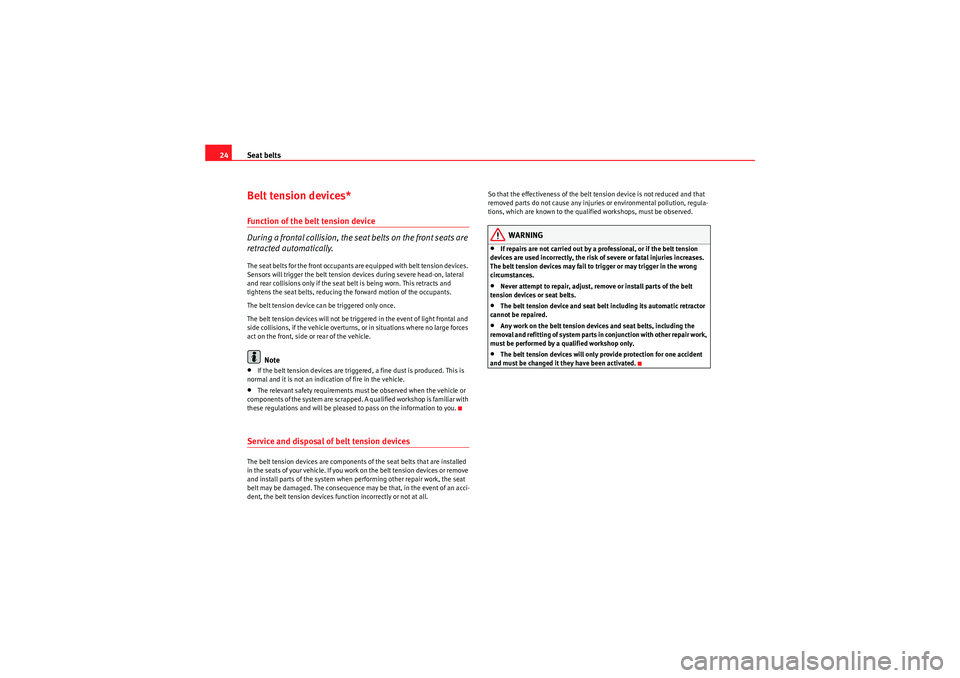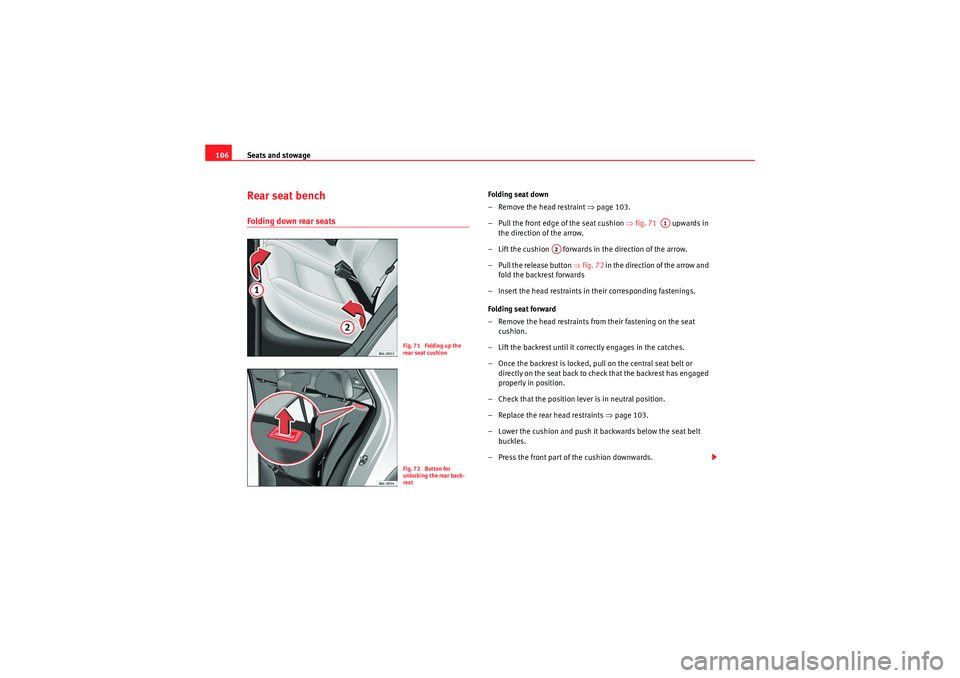2009 Seat Ibiza 5D remove seats
[x] Cancel search: remove seatsPage 26 of 257

Seat belts
24Belt tension devices*Function of the belt tension device
During a frontal collision, the seat belts on the front seats are
retracted automatically.The seat belts for the front occupants are equipped with belt tension devices.
Sensors will trigger the belt tension devices during severe head-on, lateral
and rear collisions only if the seat belt is being worn. This retracts and
tightens the seat belts, reducing the forward motion of the occupants.
The belt tension device can be triggered only once.
The belt tension devices will not be triggered in the event of light frontal and
side collisions, if the vehicle overturns, or in situations where no large forces
act on the front, side or rear of the vehicle.
Note
•If the belt tension devices are triggered, a fine dust is produced. This is
normal and it is not an indication of fire in the vehicle.•The relevant safety requirements must be observed when the vehicle or
components of the system are scrapped. A qualified workshop is familiar with
these regulations and will be pleased to pass on the information to you.Service and disposal of belt tension devicesThe belt tension devices are components of the seat belts that are installed
in the seats of your vehicle. If you work on the belt tension devices or remove
and install parts of the system when performing other repair work, the seat
belt may be damaged. The consequence may be that, in the event of an acci-
dent, the belt tension devices function incorrectly or not at all. So that the effectiveness of the belt tension device is not reduced and that
removed parts do not cause any injuries or environmental pollution, regula-
tions, which are known to the qualified workshops, must be observed.
WARNING
•If repairs are not carried out by a professional, or if the belt tension
devices are used incorrectly, the risk of severe or fatal injuries increases.
The belt tension devices may fail to trigger or may trigger in the wrong
circumstances.•Never attempt to repair, adjust, remove or install parts of the belt
tension devices or seat belts.•The belt tension device and seat belt including its automatic retractor
cannot be repaired.•Any work on the belt tension devices and seat belts, including the
removal and refitting of system parts in conjunction with other repair work,
must be performed by a qualified workshop only.•The belt tension devices will only provide protection for one accident
and must be changed it they have been activated.
Ibiza_EN.book Seite 24 Montag, 14. September 2009 6:19 18
Page 33 of 257

Airbag system31
Safety First
Controls and equipment
Practical tips
Technical Data
The airbag system is not a substitute for seat belts, but it is an integral part
of the vehicle's overall passive safety system. Please bear in mind that the
airbag system can only work effectively when the occupants are wearing their
seat belts. For this reason, it is most important to wear the seat belts at all
times, not only because this is required by law in most countries, but also as
a contribution to your own safety
The side airbag system will not be triggered if:
•the ignition is switched off,•there is a minor side collision,•there is a frontal collision,•there is a rear-end collision,•the vehicle turns over.
The main parts of the airbag system are:•an electronic control and monitoring system (control unit),•the side airbags in the sides of the backrests of the front seats,•a warning lamp
in the dash panel insert ⇒page 26.
The airbag system operation is monitored electronically. The airbag warning
lamp will light up for approx. 4 seconds every time the ignition is switched on
(self-diagnosis).
WARNING
•Never drive the vehicle if the interior panels have been removed.•Never drive if the interior door panels have been removed or if the
panels have not been correctly fitted.•Never drive the vehicle if the loudspeakers in the door panels have
been removed, unless the holes left by the loudspeakers have been
correctly closed.•Always check that the openings are closed or covered if loudspeakers
or other equipment are fitted in the interior door panels.
•Any work carried out to the doors should be made in a qualified author-
ised workshop.•The seat belts and airbags can only provide maximum protection if the
occupants are seated correctly ⇒page 9, “Proper sitting position for occu-
pants”.•If a fault has occurred in the airbag system, have the system checked
immediately by a qualified workshop. Otherwise, during a side collision,
the system may fail to trigger, or not trigger correctly.
Function of side airbags
Inflated airbags can reduce the risk of head or chest injury in
many side impact collisions.In some side collisions the side airbag is triggered on the impact side of the
vehicle ⇒fig. 20 .
WARNING (continued)
Fig. 20 Inflated side
airbag on left side of
vehicle
Ibiza_EN.book Seite 31 Montag, 14. September 2009 6:19 18
Page 104 of 257

Seats and stowage
102Head restraintsCorrect adjustment of head restraints
Properly adjusted head restraints are an important part of
passengers protection and can reduce the risk of injuries in
most accident situations.
– Adjust the head restraint so that the top is at the same level as
the top of your head or as close as possible to the same level as
the top of your head, at least at eye level ⇒ fig. 66 and ⇒fig. 67 .Adjusting the head restraints ⇒page 103.
WARNING
•Travelling with the head restraints removed or improperly adjusted
increases the risk of severe injuries.•Improperly adjusted head restraints could lead to death in the event of
a collision or accident.•Incorrectly adjusted head restraints also increase the risk of injury
during sudden or unexpected driving or braking manoeuvres.•The head restraints must always be adjusted according to the
passenger's height.
Fig. 66 Front view: head
restraints and seat belts
correctly adjusted
Fig. 67 Side view: head
restraints and seat belts
correctly adjusted
Ibiza_EN.book Seite 102 Montag, 14. September 2009 6:19 18
Page 105 of 257

Seats and stowage103
Safety First
Controls and equipment
Practical tips
Technical Data
Removing or adjusting head restraints
The head restraints can be adjusted by moving them up and
down.Adjusting height (front seats)
– Press the button on the side and pull upwards to the desired
position.
– To lower the head restraint, press the button and push head
restraint downwards.
– Make sure that it engages securely into position.
Adjusting height (rear seats)
– Press the button on the side and pull upwards to the desired position. – To lower the head restraint,
press the button and push head
restraint downwards.
– Make sure that the head restraint engages securely in one of its positions ⇒page 13.
Removing the head restraint
– Push the head restraint up as far as it will go.
– Press the button ⇒fig. 68 (arrow).
– Pull head restraint out of fitting without releasing the button.
Fitting the head restraint
– Insert the head restraint into the guides on the rear backrest.
– Push head restraint down.
– Adjust the head restraint to suit body size ⇒page 12.
WARNING
•Never drive if the head restraints have been removed. Risk of injury.•Never drive if the head restraints are in an unsuitable position, there is
a risk of serious injury.•After refitting the head restraint, you must always adjust it properly for
height to achieve optimal protection.•Please observe the safety warnings on ⇒page 102, “Correct adjust-
ment of head restraints”.Note
•To fit and remove the rear head restraints, gently tilt the seat backrest
forwards.
Fig. 68 Adjusting and
removing the head
restraints
Ibiza_EN.book Seite 103 Montag, 14. September 2009 6:19 18
Page 108 of 257

Seats and stowage
106Rear seat benchFolding down rear seats
Folding seat down
– Remove the head restraint ⇒page 103.
– Pull the front edge of the seat cushion ⇒ fig. 71 upwards in
the direction of the arrow.
– Lift the cushion forwards in the direction of the arrow.
– Pull the release button ⇒fig. 72 in the direction of the arrow and
fold the backrest forwards
– Insert the head restraints in their corresponding fastenings.
Folding seat forward
– Remove the head restraints from their fastening on the seat cushion.
– Lift the backrest until it correctly engages in the catches.
– Once the backrest is locked, pull on the central seat belt or directly on the seat back to check that the backrest has engaged
properly in position.
– Check that the position lever is in neutral position.
–Replace the rear head restraints ⇒page 103.
– Lower the cushion and push it backwards below the seat belt buckles.
– Press the front part of the cushion downwards.
Fig. 71 Folding up the
rear seat cushionFig. 72 Button for
unlocking the rear back-
rest
A1
A2
Ibiza_EN.book Seite 106 Montag, 14. September 2009 6:19 18
Page 117 of 257

Seats and stowage115
Safety First
Controls and equipment
Practical tips
Technical Data
•An overloaded boot could mean that the rear stowage tray is not correctly
seated and it may be bent or damaged.•If the boot is overloaded, remove the tray.Note
•Ensure that, when placing items of clothing on the luggage compartment
cover, rear visibility is not reduced.Roof carrier*Please observe the following points if you intend to carry loads on the roof:•For safety reasons, only luggage racks and accessories approved by SEAT
should be used.•It is imperative to precisely follow the fitting instructions included for the
rack, taking special care when fitting the front bar in the holes designed for
this and the rear bar between the marks on the upper part of the rear door
frame while respecting the correct direction of travel indicated in the installa-
tion manual. Not following these instructions may damage the bodywork.•Pay special attention to the tightening torque of the attachment bolts and
check them following a short journey. If necessary, retighten the bolts and
check them at regular intervals.•Distribute the load evenly. A maximum load of 40 kg only is permitted for
each roof carrier system support bar, the load must be distributed evenly
along the entire length. However, the maximum load permitted for the entire
roof (including the support system) of 75 kg must not be exceeded nor should
the total weight of the vehicle be exceeded. See the chapter on “Technical
Data”.•When transporting heavy or large objects on the roof, any change in the
normal vehicle behaviour due to a change in the centre of gravity or an increased wind resistance must be taken into account. For this reason, a suit-
able speed and driving style must be used.
•For those vehicles fitted with a sunroof*, ensure that it does not interfere
with the load on the roof carrier system when opened.
Ibiza_EN.book Seite 115 Montag, 14. September 2009 6:19 18